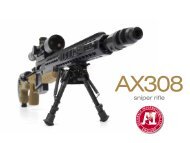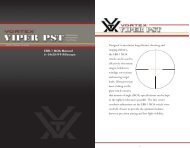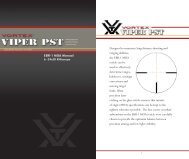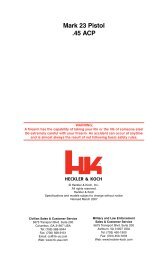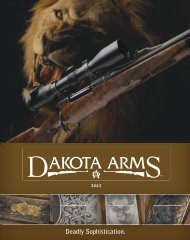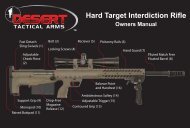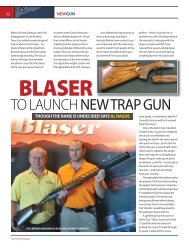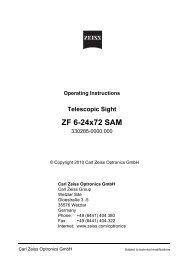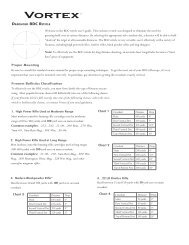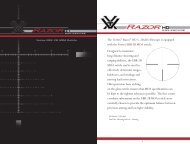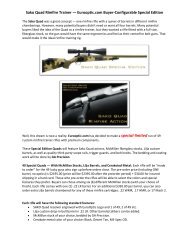vortex viper pst 4-16x50 FFP rifle scope manual - EuroOptic.com
vortex viper pst 4-16x50 FFP rifle scope manual - EuroOptic.com
vortex viper pst 4-16x50 FFP rifle scope manual - EuroOptic.com
Create successful ePaper yourself
Turn your PDF publications into a flip-book with our unique Google optimized e-Paper software.
FIRST FOCAL PLANEVortex EBR-1 MOA ReticlePRECISIONSHOOTINGTACTICALEBR-1 MRAD Manual4–<strong>16x50</strong> <strong>FFP</strong> Rifle<strong>scope</strong>Designed to maximize long distance shooting andranging abilities,the EBR-1 MRADreticle can be used toeffectively determineranges, holdovers,windage correctionsand moving targetleads. Ultra precisionlaser etching onthe glass reticleensures that mrad specifications can be kept to thetightest tolerances possible. The fine center crosshairsubtensions on the EBR-1 MRAD reticle were carefullychosen to provide the optimum balance betweenprecision aiming and low light visibility.1
MRAD SubtensionsThe EBR-1 MRAD reticle is based on themilliradian, or mrad for short. Mrad unit of arcmeasurements are based on the radian. A radianis the angle subtended at the center of a circle byan arc that is equal in length to the radius of thecircle. There are 6.283 radians in a circle and1000 milliradians in a radian for a total of 6283milliradians (mrads) in a circle. An mrad willsubtend 3.6 inches at a distance of 100 yards. Most<strong>rifle</strong><strong>scope</strong>s with mrad adjustments use .1 mradclicks which subtend .36 inches at 100 yards.EBR-1 Mrad Reticle SubtensionsIn a first focal plane <strong>rifle</strong><strong>scope</strong>, the listed mradsubtensions of the EBR-1 reticle are valid at allmagnification levels. This means the shooter can use themagnification level most appropriate for the situationand still have effective holdover and windage referencemarks. This is also extremely valuable in a high-stresssituation, as the shooter does not have to remember toset the <strong>scope</strong> to one particular magnification to get validholdovers—an action necessary with the more <strong>com</strong>monsecond focal plane reticles.Both mrad and MOA measurements are effectivefor ranging and bullet trajectory drop <strong>com</strong>pensationin reticle designs. However, the mrad method usedin the EBR-1 MRAD reticle has some importantadvantages over an MOA method. The primarybenefit is that once learned, it is much simpler andfaster to use. The mrad system will also be veryeasy for shooters familiar with the metric systemand for those shooters with previous training inusing mil dot reticles.Heavy crosshairsubtends .8 mrads.2 mrads 1 mradFine crosshairsubtends .06 mradsGap subtends1 mrad2 3
RangingMrad reticles such as the EBR-1 are very effective forranging using simple formulas.Mrad Ranging FormulasExampleTarget Size (Yards) x 1000mrads Read=Range (Yards)Target Size (Meters) x 1000mrads Read=Range (Meters)Target Size (Inches) x 27.8mrads Read=Range (Yards)To use these formulas, you will need to know themeasured size of the target or a nearby object. Usingeither the vertical or horizontal mrad scale, place thereticle on the target of known measurement and readthe number of mrads spanned.Accurate measuring will depend on a very steadyhold—the <strong>rifle</strong> should be solidly braced using a rest,bipod or sling. Once you have an accurate mradreading, use any of the listed ranging formulas tocalculate distance.Maximum accuracy in ranging will be obtained bycalculating exact mrad measurements—mrads shouldbe estimated in tenths if possible.Ranging a man (1 meter from groin to top of head) at2 mrads yields 500 meters.1 x 1000= 500 Meters2 mrads4 5
Elevation HoldoversOnce the distance has been calculated using the EBR-1 MRAD reticle or a laser rangefinder, the EBR-1 canbe used for rapid holdover correction for bullet dropof the cartridge being used. To get the most benefitout of the EBR-1 equipped <strong>rifle</strong><strong>scope</strong>, Vortex Opticshighly re<strong>com</strong>mends shooters learn their bullet dropnumbers in mrads rather than inches or MOAs.(Remember that 1 mrad equals 3.44 MOA or 3.6inches per 100 yards).ExampleSince the EBR-1 reticle is scaled in mrads, it is aneasy job to quickly select the correct drop referenceline once the shooter knows knows their bulletdrops and windage/lead corrections in mrads. If theshooter prefers to dial <strong>com</strong>e ups for bullet drop usingthe elevation knob, knowing bullet drops in mradswill allow for much faster adjustments as the mradscan be quickly read on the elevation knob.7.7 mrad correction for 800-yard shot. No wind.6 7
Windage and Moving TargetsThe EBR-1 reticle is highly effective when used forwind and moving target leads.Using the reticle for windage and moving leads willrequire thorough knowledge of your weapon system’sballistic performance under varying conditions andexperience in reading wind strengths and targetspeeds. As in bullet drops, it is imperative the shooterlearn the particular weapon’s windage/moving targetcorrections in mrads rather than inches or MOAs.Example15 mph windFull value wind at 90 degreesBasic windage correction on center crosshairWhen dialing elevation <strong>com</strong>e ups, the center horizontalcrosshair will be used for windage or moving leadcorrections.2.6 mrad correction for 15 mph wind at 700 yards.Elevation already dialed into turret.8 9
Basic windage correction using drop line on reticleWhen using the reticle for elevation correction rather thandialing, the mrad marks on the center horizontal crosshair canstill be used to help visually reference windage corrections.Example20 mph windFull value wind at 90 degreesBasic moving lead correctionWhen estimating moving target leads, the mrad marks on thecenter horizontal crosshair can be used. Estimating movingleads will require knowing yardage distance, wind speed,moving target speed and total bullet flight times including <strong>rifle</strong>lock time. Bullet flight times can be roughly calculated basedon fps velocities or a ballistic calculator.Note: Correctly estimating moving leads is very diffi cult and requiresconsiderable practice and knowledge beyond the <strong>scope</strong> of this <strong>manual</strong>.ExampleWalking DirectionUsing 3 mrad drop line at 500 yards, 4.0 mrad correction for 20 mph wind.2.74 mrad correction for a man walking at 3 mph at 800 yards. No wind.Total bullet time of fl ight from trigger pull 1.5 seconds during which mantravels 6.6 feet. Elevation already dialed into turret.10 11
Vortex Service and Repair Policy<strong>vortex</strong>optics.<strong>com</strong>Unconditional Lifetime WarrantyVortex Optics wants you to shootand use your Viper PST <strong>rifle</strong><strong>scope</strong>under any conditions with<strong>com</strong>plete confidence—that’s whyour warranty is straightforwardand simple:• Fully transferableUnconditional LifetimeWarranty• No warranty card needed• No receipt neededRest assured, if this <strong>rifle</strong><strong>scope</strong> should ever require repair, allyou need to do is contact Vortex for absolutely free service.Call 800-426-0048 or e-mail service@<strong>vortex</strong>optics.<strong>com</strong>.Vortex Optics2120 West Greenview DriveMiddleton, Wisconsin 53562USAPatent PendingDual Use: Shooting Tactical / HuntingManual #R-416F1-M12



